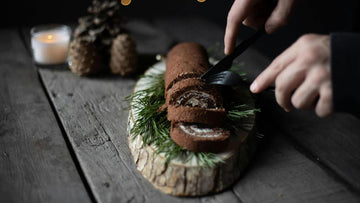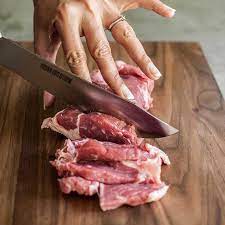The Benefits of Using a Walnut Cutting Board in Your Kitchen.
by Jerry Barker on Dec 15, 2023

Wood cutting boards have served in kitchens over the years, known for their endurance, ease of treatment, and protecting the edge of the knife. provided.
And when it comes to wood cutting boards, there is one clear winner in terms of quality, performance, and beauty: the walnut cutting board.
If you intend to buy a new cutting board for your kitchen, these are the reasons for choosing walnut tops above all others.
Why Walnut is the Ideal Material for Kitchen Cutting Boards:
Walnut has many inherent properties that make it exceptionally well-suited for use as kitchen cutting boards:
Hardness Protects Knives:
Dense hardwood walnuts have a hardness rating of 1010 on the Janka scale. This extreme hardness prevents the knives from getting dull or wear out when it is still in operation. Soft wood may damage the knife edges.
Tight, Stable Grain:
Walnut wood has a fine, tight grain which gives a hard wearing surface that takes normal wear for decades while barely scratching or damaging. It has firm and stable grain that makes it highly resistant to warping.
Naturally Antibacterial:
Juglone, the antiseptic contained in walnuts, is used as a preservative for food products. Such allows walnut cutting boards some antibacterial qualities to prevent pollution and foodborne diseases.
Beautiful Finishes:
Well crafted walnut cutting board with brown and darker streaks as their coloration is an artwork for the kitchen. Walnut is one of the species that stain nicely, and its different finishing alternatives just look gorgeous!
Features that Make Walnut Cutting Boards Stand Out:
Beyond the inherent benefits of walnut wood, quality walnut cutting boards include special design elements and accessories:
Durable Handles:
Ergonomic handles - often stainless steel - provide safe grip and easy handling. This prevents accidents and makes transferring the board effortless.
Juice Grooves:
The board can include handy grooves carved around the perimeter to catch errant juices from meat and other foods for cleaner countertops.
Non-Slip Feet:
Little rubber feet on the bottom keep the cutting board firmly planted on the countertop during use for reliable chopping stability.
Matching Utensils:
Other boards have a built-in drawer where the choppers and other kitchen tools can be stored away from view until needed later.
How a Walnut Cutting Board Can Enhance Your Cooking Experience:
The best walnut cutting boards give you more than chipping for durability – they can enhance all your kitchen and cooking.
Elegant Serving Platter:
Walnut board is also very good as the cutting board transits easily from food preparation to serving with its rich finish. Display your charcuterie, cheese platters, and fresh bread on it at the table in an artistic manner.
Sophisticated Design Showpiece:
A walnut-finished cutting for the kitchen mounted against a wall and/or laid out on a countertop will serve not only as a functional item, but also as a very nice decorative element indicating exquisite taste.
Kitchen Heirloom:
A well taken care of a walnut cutting board is bound to last you and even your children’s lifetime. Quality in cuttings means that the best cuttings become better with years.
Different Types of Walnut Cutting Boards:
Walnut cutting boards come in various shapes, sizes, and designs to suit different kitchen tasks and spaces:
Walnut Butcher Block Cutting Boards:
Walnut Butcher Block Cutting Boards:
Extra-large and thick walnut butcher block panels offer wide stable chopping surface suitable for large meat cuts or preparation meals.
Best Uses:
- Chopping large quantities of ingredients
- Raw meat/seafood prep
- Bread/pastry dough rolling
Walnut Wide Plank Cutting Board:
For smaller counters and wider open work surfaces, long, narrow walnut logs provide a thinner silhouette while still providing a huge rectangle of cutting space.
Best Features:
- Space-saving rectangular shape
- Grooved design with juice runoff
- Easy wall mounting
Black Walnut Cutting Boards:
Prized for striking good looks, rich black walnut has dramatic dark graining and makes a sophisticated statement in any kitchen.
Pros:
- Deepest color shows less wear
- Smooth sanded finish
- Visually appealing contrast
Customizable Walnut Cutting Boards:
For a personalized touch, custom walnut boards can be crafted to order in special sizes, shapes, engraving, edge profiles, and finish options.
Customization Options:
- Monogram or name engraving
- Custom edge shaping
- Unique finish choices
- Heirloom gift potential
Maintaining and Caring for Your Walnut Cutting Board:
With proper care and maintenance, a quality walnut cutting board will serve for decades as your kitchen's most valued multitasker.
Regular Oiling:
Oil finishes keep walnut boards sealed against moisture and stains. Re-oil periodically with food-safe mineral oil to maintain the attractive finish.
Sanitizing Routine:
Wash with hot soap and water after each use. Occasionally sanitize by rubbing with a citrus juice and salt paste to kill bacteria.
No Dishwasher!
The harsh heat and detergent of the dishwasher will damage the finish and integrity of a prized walnut board. Always hand wash to preserve quality and longevity.
Correct Storage:
Store walnut boards out of direct sunlight to avoid fading. Vertical mounts or wall racks help maximize space while putting gorgeous boards decoratively on display.
Comparing Walnut Cutting Boards to Other Wood Options:
Walnut has distinct advantages over other wood cutting board varieties in terms of performance, beauty, value, and durability over years of use.
Vs. Maple Cutting Boards:
While maple is dense, straight-grained, and smooth, it lacks walnut's unparalleled hardness and tight grain structure. Frequent oiling is required to maintain maple boards. Walnut retains its rich patina longer.
Vs. Cherry Cutting Boards:
Cherry wood is slightly softer than walnut, making it more vulnerable to cut marks and wear with extensive use. Its red tone also tends to fade to brown over time unlike walnut.
Vs. Ash Cutting Boards:
Pale ash wood lacks visual warmth and exhibits a wide, porous grain that requires extra oiling. Walnut has a tighter wood grain that better resists damage from knives or moisture penetration.
How thick should a good walnut cutting board be?
At the minimum, it should be 1″ thick to avoid excess strain. Thinner boards have high friction and wear out more than thicker end grain boards which tend to be very heavy.
Can one carve meat with a walnut board?
A walnut board is ideal for cutting meat; provided this is done after cleaning. It is advisable to use a different meat board to avoid contamination.
Which kind of wood should one use when making cutting boards?
It is probably the single best wood for residential kitchen cutting, especially considering the tight grain, high density, hardness, looks and appearance, shock absorbance and natural “antibacterial” oils it contains.
Conclusion:
A walnut cutting board is built to last for generations as the ultimate kitchen multitasker. Offering supreme knife protection, stability, beauty, and even antibacterial properties, walnut is clearly the superior choice over other wood options. With elegant design touches like juice grooves, grips, engraved surfaces, and more, a custom walnut cutting board makes a meaningful heirloom gift or upgrade for your own kitchen. Well-crafted and properly maintained, this functional showpiece will serve dutifully at the heart of food preparation for decades to come!




